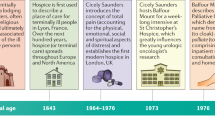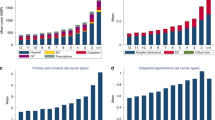Abstract
The priority for care at the end of life is to ensure that all patients experience high-quality care, irrespective of their diagnosis or preferred place of care. This phase of an individual's disease journey is fraught with complex decision-making that can obscure and impair the provision of high-quality care in the absence of advance care planning. In the past few years, the Department of Health in the UK has emphasized this through a number of initiatives and strategies aimed at preparing patients, carers, and indeed professionals, for the terminal phase of disease. This Review explores these initiatives and demonstrates, through the discussion of a recent case history of an individual with a diagnosis of a urological malignancy, how they have been implemented at a local level by The Royal Marsden NHS Foundation Trust.
Key Points
-
The priority for care at the end of life is to ensure that all patients experience high-quality care, irrespective of their diagnosis or preferred place of care
-
The Department of Health in the UK has issued a number of initiatives and strategies aimed at preparing patients and carers for the terminal phase of disease
-
The End of Life Care Strategy emphasizes a coordinated pathway approach
-
The Hospital2Home project at The Royal Marsden NHS Foundation Trust aims to reduce unnecessary hospital admissions and increase the proportion of patients dying in their preferred place
-
The Department of Health is currently developing a locality-wide, end-of-life register to further improve communication about end-of-life care preferences between health-care settings
This is a preview of subscription content, access via your institution
Access options
Subscribe to this journal
Receive 12 print issues and online access
$209.00 per year
only $17.42 per issue
Buy this article
- Purchase on Springer Link
- Instant access to full article PDF
Prices may be subject to local taxes which are calculated during checkout

Similar content being viewed by others
References
Department of Health End of Life Care Strategy: promoting high quality care for all adults at the end of life[online], (2008).
Healthcare Commission Spotlight on Complaints: a report on second-stage complaints about the NHS in England [online], (2007).
Department of Health The NHS Cancer Plan: a plan for investment, a plan for reform [online], (2000).
National Institute for Clinical Excellence Improving Supportive and Palliative Care for Adults with Cancer [online], (2004).
World Health Organization National Cancer Control Programmes: policies and managerial guidelines [online], (2002).
National Health Service The National End of Life Care Programme [online],
National Health Service Gold Standards Framework [online],
National Health Service Preferred Priorities for Care [online],
Marie Curie Cancer Care The Liverpool Care Pathway [online],
Omega, The National Association for End of Life Care End of Life Care in Primary Care: 2009 national snapshot [online], (2009).
Skills for Care [online],
Skills for Health [online],
e-Learning for Healthcare End of Life Care For All (e-ELCA) [online],
National Health Service The National End of Life Care Programme Newsletter, Issue 18 [online], (2010).
Marie Curie Cancer Care Delivering Choice Programme [online],
Addicott, R., Dewar, S ; The King's Fund Improving Choice at End of Life [online], (2008).
Department of Health End of Life Care Strategy: first annual report [online], (2009).
Department of Health End of Life Care Strategy: quality markers and measures for end of life care [online], (2009).
Higginson, I. J. & Sen-Gupta, G. J. Place of care in advanced cancer: a qualitative systematic literature review of patient preferences. J. Palliat. Med. 3, 287–300 (2000).
Office for National Statistics Mortality Statistics: deaths registered in 2008 [online], (2009).
Abernethy, A. P. et al. A pragmatic 2 × 2 × 2 factorial cluster randomized controlled trial of educational outreach visiting and case conferencing in palliative care-methodology of the Palliative Care Trial [ISRCTN 81117481]. Contemp. Clin. Trials 27, 83–100 (2006).
Mitchell, G. et al. General practitioner, specialist providers case conferences in palliative care—lessons learned from 56 case conferences. Aust. Fam. Physician 34, 389–392 (2005).
Smith, C. et al. Can we bridge the gap? Hospital2Home: The unity of acute and community end of life care. Poster presentation at the 8th Palliative Care Congress, Association for Palliative Medicine, Bournemouth, UK. 10–12 March 2010.
Author information
Authors and Affiliations
Corresponding author
Ethics declarations
Competing interests
The authors declare no competing financial interests.
Rights and permissions
About this article
Cite this article
Wood, J., Smith, C. End-of-life care: preparing patients and families. Nat Rev Urol 7, 425–429 (2010). https://doi.org/10.1038/nrurol.2010.82
Published:
Issue Date:
DOI: https://doi.org/10.1038/nrurol.2010.82



